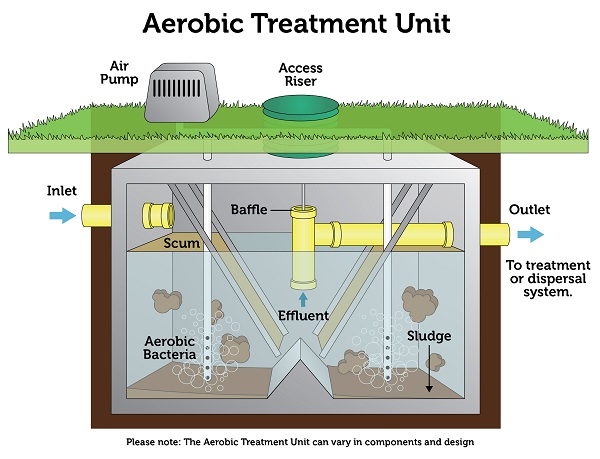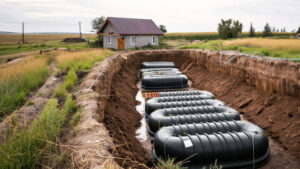How to Identify Your Septic Tank Type:
Understanding Septic Systems
Before exploring the various septic tank types, it’s crucial to understand what a septic system is and how it functions. A septic system is an underground wastewater treatment structure, commonly used in rural areas without centralized sewage systems. It comprises three main components:
- Septic tank
- Drain field
- Soil absorption field
Wastewater from your home flows into the septic tank, where it undergoes initial treatment. The treated effluent is then distributed into the drain field for further purification by the soil.
Types of Septic Tanks
1. Conventional Septic Tanks
Description: Conventional septic tanks are the most common type, consisting of one or two tanks made of concrete, fiberglass, or polyethylene. They feature a Tee or baffle at the inlet to prevent the floating scum layer from clogging the outlet.
Materials: Concrete, fiberglass, or polyethylene
2. Chamber Septic Tanks
Description: Also known as alternating septic systems, chamber septic tanks have multiple chambers instead of a single tank. Wastewater flows from one chamber to another, promoting better treatment.
Materials: Concrete or polyethylene
3. Aerobic Septic Tanks
Description: Aerobic septic tanks use aeration to accelerate waste decomposition, resulting in cleaner effluent. They typically include a compressor, aerator, and clarifying chamber.
Materials: Concrete, fiberglass, or polyethylene
4. Drip Distribution Septic Systems
Description: Drip distribution systems evenly distribute wastewater over a large area using a network of small pipes and emitters. They’re often used in areas with high water tables or poor soil conditions.
Materials: PVC or polyethylene pipes
5. Mound Septic Systems
 Description: Mound septic systems are raised sand mounds that treat wastewater. They’re used in areas with shallow soil depth or high groundwater levels.
Description: Mound septic systems are raised sand mounds that treat wastewater. They’re used in areas with shallow soil depth or high groundwater levels.
Materials: Sand, gravel, and geotextile fabric
How to Inspect and Identify Your Septic Tank
Now that you’re familiar with the different types of septic tanks, let’s explore how to inspect and identify yours.
Locating your septic tank
- Review your property records and contact your local health department for information about your septic system’s location.
- Conduct a physical inspection of your property, looking for signs of a septic system such as a rectangular or cylindrical lid in your yard, near your house, or close to your drain field.
Inspecting the tank components
- Check for the lid, inlet, and outlet pipes. Conventional and chamber septic tanks typically have one inlet and one outlet pipe, while aerobic tanks may have multiple pipes.
- Measure the tank’s length, width, and height to estimate its size and shape. Most residential tanks range from 500 to 1,500 gallons.
- Look for a distribution box, which is likely present in conventional or chamber septic systems.
Determining the type of septic tank
- Compare your observations with the descriptions provided in this guide to make an educated guess about your septic tank type.
- Look for signs of aeration or multiple chambers, which can indicate an aerobic or chamber septic tank.
- If you’re unsure, consider consulting a professional septic system inspector for a definitive assessment.
Conclusion
Identifying your septic tank type is crucial for proper maintenance and repair. Regular inspections and pumping can prevent costly repairs and extend the life of your septic system. Use this guide as a starting point, and don’t hesitate to consult a professional if you’re unsure about your septic tank type or need assistance with maintenance or repairs.








